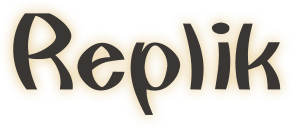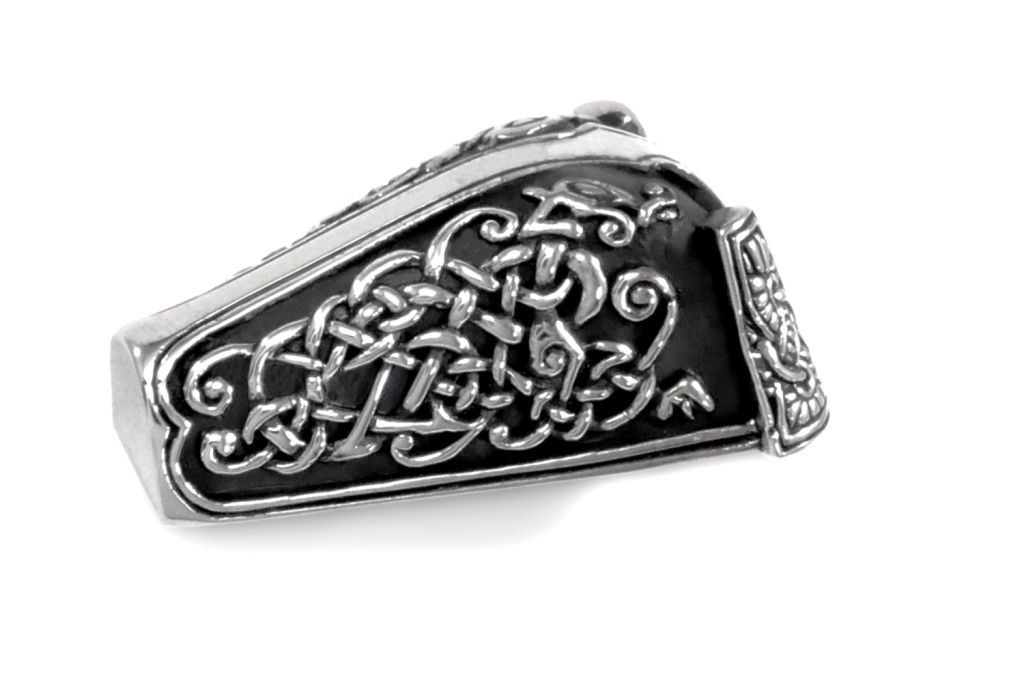Animal Head Brooch Ringerike Style, Gotland, Silver
Animal head brooch from Gotland decorated in Ringerike-style (Runestone style) of the late 10th - 11th century. They often were worn as a pair to hold some kind of a apron dress.
Animal Head Brooch from Gotland
The original find of this brooch is in the collection of the British Museum in London. Our replica (model made by Thoke Fischer) was cast by hand from solid silver. The large fields are blackened, which gives the brooch a very noble appearance. The animal head brooch is made in two parts with a separate decorated base. The length is 58 mm, the width 43 mm, the height about 33 mm incl. base and needle.
The needle of the animal head brooch is made and forged separately according to the original patterns. If desired, a flexible steel needle (reenactment needle) can be fitted, which has a greater spring tension and leaves smaller holes in the fabric. Fixing holes or rings to hang equipment or intermediate chains can also be considered.
Our animal head brooch bears an ornamentation of ribbon bars, as found on the oldest brooches of this type. The focus of this early ornamentation is the period from about 800 AD to the early 10th century. However, our model, together with four other examples, forms its own type group, which has additional ornaments with a stepped meander pattern and cannot be further dated due to a lack of find connections. Based on the meander pattern, however, I would assume a younger date (11th century, level VIII-3 to VIII-4).
The price refers to 1 piece.
Animal Head Brooches - The Viking Age on Gotland
The name "animal-head brooch" is a modern archaeological term referring to the shape of the brooches, which remotely resembles a bear's or bull's head. Around 1750 examples of this type have been found on Gotland, which is exclusively associated with women's costume. They were worn both as couples' brooches and as single brooches.
In contrast to the rest of Scandinavia, Gotland had an independent costume culture with special forms of jewellery and fibulae. While in other places combinations of oval and cloverleaf fibulae are often found, in Gotland the so-called animal-head and box fibulae were preferred. The smaller animal-head brooches took over the function of the oval or turtle brooches, which were often worn in pairs to hold the wearers of an apron dress. The ostentatious box brooch is found in the centre of the neck in richer graves, where it was probably used as a single "solitaire brooch" to close a thicker cloak.

Find situation of a brooch ensemble with animal head brooches and box brooch in the Visby Museum, Gotland.
A total of about 1750 animal-headed fibulae have been discovered on Gotland, of which about 120 come from well-documented skeletal burials. Slightly more than half possessed more than one brooch, most burials had a couple of animal head brooches and a third brooch beside them. In most cases this was a box brooch, but it could also be an animal head brooch of a different type or a stirrup disc brooch. The position of the animal head brooches varies from the height of the collar bones down to the height of the elbow, whereby the animal head brooches were probably worn in most cases at the level of the middle of the upper arm. In most cases, the narrow side of the brooch points diagonally outwards/upwards. The brooch was usually placed on the neck, in a few exceptional cases in the area of the waist or on the belly.
The special Viking costume of Gotland has its origins in the Vendel period between 550 and 800 B.C. The older type of solitaire brooch is the splendid disc brooch as the central ornament of the women's costume. At the beginning of the Viking Age, these magnificent brooches were often decorated with elaborate gold plate inlays and precious stones. As early as the late Vendel period, the likewise very decorative box brooches appeared, whose shape was reminiscent of the attached bow disc of the bow disc brooches. In the course of the Viking Age, the bow-disk brooches disappear completely, and the character of the box brooch also changes from a ceremonial brooch to a simple utility brooch. The animal-headed brooches, on the other hand, can basically be regarded as purely utilitarian brooches, even if a few examples were made of silver or with gilding and were correspondingly expensive.

In addition to the actual purpose of fastening clothing, many brooches fulfilled other functions. In the case of animal head brooches, there are often holes arranged in pairs on the base plates, which suggest that the brooches were connected by a chain construction. However, such chains are rarely found in the graves, which may also be due to burial customs.
Now and then, individual animal-head brooches were also equipped with implement chains to which amulets, keys and other objects were attached.
Both animal-headed and tin fibulae are also very suitable as containers. In some cases, coins, wool, threads and organic substances were found inside the fibulae. Practical purposes as well as incurable substances and "magic herbs" are conceivable.
Literature:
Lena Thunmark-Nylen. Die Wikingerzeit Gotlands, Band I bis IV, Stockholm
| Delivery time | 3-4 weeks |
|---|---|
| weight | 0.100000 |
| size | 60 mm |
| Era | Vikings |
| Material | Silver 925 |
| Kind of replica | Fibulae and Brooches |
| scope of delivery | Delivery in a jewellery case with certificate |

